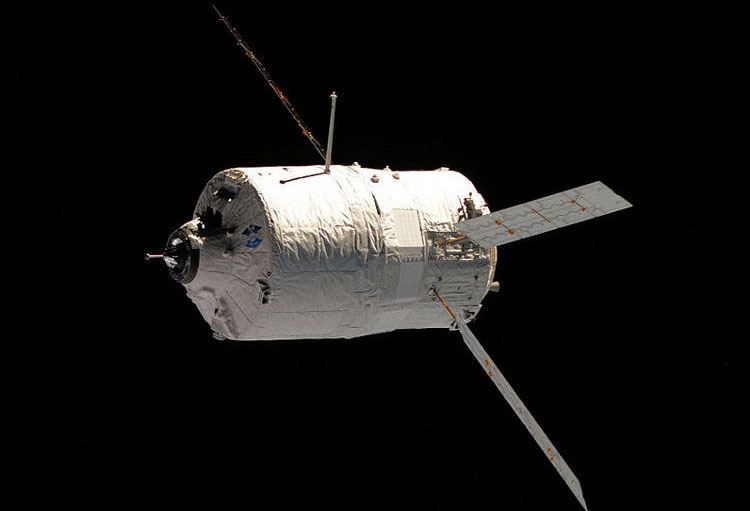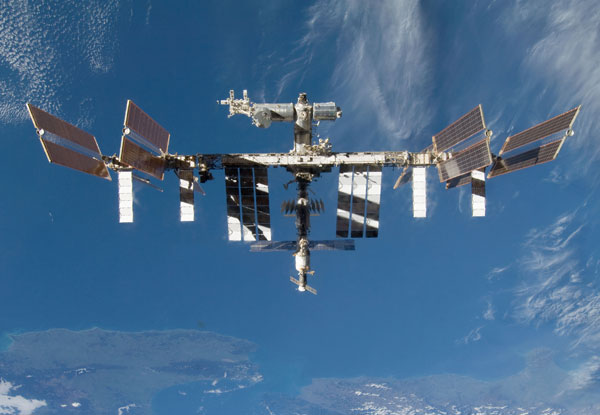International Space Station increased the orbit by 1.5km
European ATV-3 unmanned space transport ship on May 26 helped bring the International Space Station (ISS) trajectory up by 1.5km, according to RIA Novosti.
The two main engines of the ATV-3 ship, Edoardo Amaldi, are now connected to ISS's Zvezda module, starting at 7-10 am on May 26 (VN time) to propel ISS into new orbit. at an average altitude of 399.3km, an increase of 1.5km of height compared to the previous position

Europe's supply ship Edoardo Amaldi
It is known that ATV-3 is the third automatic transport ship of the European Space Agency (ESA) named after 20th-century Italian physicist Edoardo Amaldi, bringing 6.6 tons of cargo including fuel , drinking water, oxygen, food . to provide for ISS.
The ship arrived to assemble with the port of the Zvezda logistics module on March 29, after being launched into space using Ariane 5 rocket from Kourou Space Airport in French Guiana on March 23.
Reportedly, before the ship Edoardo Amaldi, two other transport ships were also launched by ISA, the ATV-1, Jules Verne, launched on March 9, 2008 and the ATV-2 named Johannes Kepler, launched on February 16, 2011.
In addition to the mission of supplying cargo to the space station and taking away waste, the European ATV fleet also performs another important task to help push the station to a higher orbit by means of the ship.
Raising the orbit for ISS was carried out regularly to help this $ 100 billion space station compensate for the loss of altitude due to the gravity of the earth, as well as to facilitate ISS to connect with ships. Space.

There are six astronauts working on ISS
Accordingly, this ISS elevation mission aims to help the Soyuz TMA-3M spacecraft of Russia carry three safe ISS astronauts, as well as ensure the successful connection of Soyuz TMA-05M.
According to RIA Novosti, Soyuz TMA-3M will carry three US astronauts Donald Pettit (USA), Oleg Kononenko (Russia) and Dutch astronaut Andre Kuipers to Earth on July 1.
Meanwhile, Soyuz TMA-05M is expected to leave the launch platform on July 15, carrying three astronauts Yuri Malenchenko (Russia), Sunita Williams (USA) and Akihiko Hoshide (Japan) to join. 32th ISS international fleet.

The Soyuz TMA-04M leaves the launch pad at Russia's Baikonur Cosmodrome in Kazakhstan
The ISS currently has an ISS 31 international fleet with six astronauts working. In addition to the three Soyuz TMA-3M astronauts, three were taken to the station on May 17 by the Soyuz TMA-04M, the Gennady Padalka, Sergei Revin (the same Russian) and Joe Acaba (USA). The Soyuz TMA-04M is expected to return home on September 17.
- ISS increased its trajectory to receive supply ships
- International space station increased altitude by 2km
- Space station increased in height to catch Soyuz
- Space station increased to receive Soyuz train
- The International Space Station is 15 years old
- Raise the trajectory of the International Space Station to 1 km
- ISS station flies over the Moon
- Raising the international space station to 2.5km
- Astronauts return to Earth safely
- Elevate the international space station about 5km higher
- Visit 'the longest road' on the ISS International Space Station
- Russia wants to place space station on another planet
 Van Allen's belt and evidence that the Apollo 11 mission to the Moon was myth
Van Allen's belt and evidence that the Apollo 11 mission to the Moon was myth The levels of civilization in the universe (Kardashev scale)
The levels of civilization in the universe (Kardashev scale) Today Mars, the sun and the Earth are aligned
Today Mars, the sun and the Earth are aligned The Amazon owner announced a secret plan to build a space base for thousands of people
The Amazon owner announced a secret plan to build a space base for thousands of people